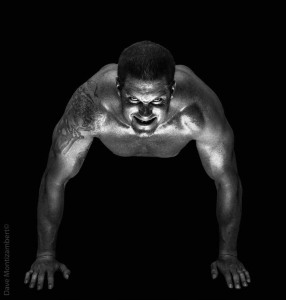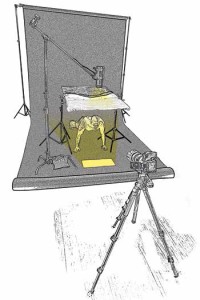articles/Lighting/cwl45bw-page1
Dave Montizambert Creating with Light Part 45 Black and White - part 1 of 1 2
by Dave Montizambert Published 01/04/2017

1
I believe photography is a beautiful abstraction of reality and that black and white (B&W) is even more so. With proper care and attention, B&W is beautiful, artful, but if you intend to create something more than the mediocre, there is much more to consider than simply applying a mono-chromatic conversion to a digital image capture. There is an infinite number of ways to create B&W; I give lighting and processing equal consideration as both are absolutely key to great mono-chromatic images.
First off photography is all about light and B&W photography is no different. Lighting for monochromatic imagery offers more freedom in the highlight end of the tonal scale than does lighting for colour imagery. Generally speaking, in B&W the highlights can be pushed higher up in the grey scale than you can in colour. Think of a fashion image in B&W where the model’s facial flesh is or is almost burned out to white. This same image in colour may not be so appealing; burned out areas of flesh in colour can make the subject look oily or greasy. Photographers have always loved lighting black flesh-tones. Generally, you shape lightertoned faces and bodies predominantly with shadow and to a much lesser degree with specular (shine, sheen). With darker flesh-tones you rely more heavily on specular and way less on shadow.

2
When I say specular I’m referring to specular highlights which are mirror images or reflections of a source of illumination imaging on the surface of your subject. This bright shine sitting on the surface of your subject makes for a dramatic contrast on darker-toned subjects and less so on lighter ones. This is why lighting dark flesh is so loved by photographers since they get to play with this specular light-form. When I was originally learning lighting back in the early 1980s, there were not that many darkskinned people to light and photograph in my home town Vancouver BC. I loved the artful figure studies that I saw of dark skinned models. I wanted to try this out but alas with no dark flesh at hand I had to get a little tricky. Knowing that the brightness of a specular highlight (called specular contrast in tech-speak), can be controlled independently from the brightness of the subject’s true tone, (called diffused value in techspeak), it occurred to me that I could turn a light person into a dark person by simply underexposing them and then showing all their shape and form by creating bright sheen or specular highlights over their face and body. I recently used this technique on an image of kick-boxer, Michael Donnellan (see image 001), from my ‘Dances With One Light – Dramatic Illumination Techniques’ lighting tutorial DVD.
You are currently on page 1
- Dave Montizambert Creating with Light Part 45 Black and White page 1
- Dave Montizambert Creating with Light Part 45 Black and White page 2
1st Published 01/04/2017
last update 09/12/2022 14:53:03
More Lighting Articles
There are 16 days to get ready for The Society of Photographers Convention and Trade Show at The Novotel London West, Hammersmith ...
which starts on Wednesday 14th January 2026





